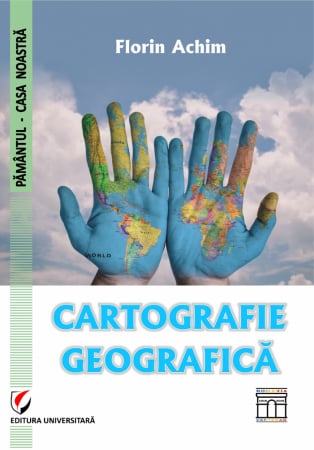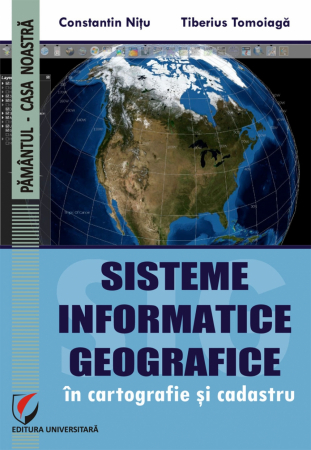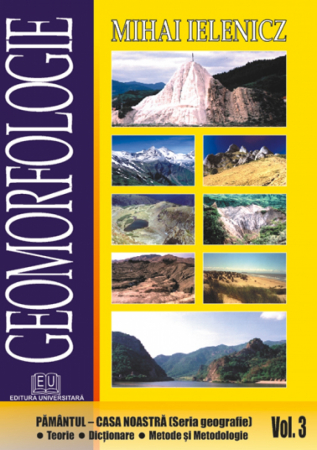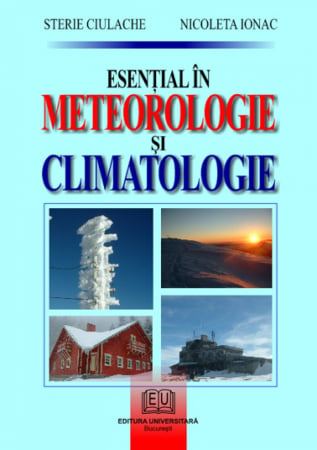ISBN: 978-973-749-022-3
Publisher year: 2006
Edition: I
Pages: 368
Publisher: Editura Universitară
Author: Melinda Candea, Irina Cimpoeru, Florina Bran
- Description
- Download (1)
- Authors
- Content
- More details
- Reviews (0)
It addresses students of geography, public and private, interested in this subject, and all professionals and researchers in the field.
-
Organizarea, amenajarea şi dezvoltarea durabilă a spaţiului geografic
Download
FLORINA BRAN
IRINA CIMPOERU
GEOGRAPHICAL SPACE. ORGANIZATION, ARRANGEMENT AND SUSTAINABLE DEVELOPMENT OF THE GEOGRAPHICAL SPACE. CONCEPT / 11
1.1. Geographical area / 11
1.2. The organization of the geographical space and the arrangement of the territory / 15
1.2.1. Spatial planning, support for the realization of programs for organizing the geographical space / 17
1.2.1.1. Spatial planning plan / 20
1.2.1.2. Sustainable development and spatial planning / 26
1.2.2. The organization of the geographical space and of the territory / 27
1.2.2.1. The role of the decisional factor in the organization of the geographical space / 31
1.2.2.2. Forms of administrative-territorial organization of the Romanian geographical space / 32
1.3. The concept of development / 39
1.3.1. Local development / 41
1.3.2. The regional dimension of development / 42
1.3.3. Regional economic development policies / 44
1.3.3.1. Principles of regional development policies / 44
1.3.3.2. The need for regional economic development policies / 46
1.3.3.3. European Charter of Regional Planning and Regional Development / 47
1.3.3.4. Recent guidelines in regional policies / 49
1.3.4. Dynamics of regional imbalances in the Romanian economy / 51
1.3.5. The objectives of the regional development strategies in Romania / 53
CHAPTER II
REGIONALIZATION - AS A TERRITORIAL APPROACH TO THE CONCEPT OF DEVELOPMENT AND AS A WAY OF ORGANIZING SPACE / 56
2.1. The concept of balanced and sustainable regional development in relation to the territory / 56
2.2. Regional approach to the concept of development at European level / 57
2.3. Regional development in Romania in the context of European regional development / 58
2.3.1. Specific regional characteristics / 62
2.3.2. The functional changes occurred in the territory and the current basic objectives of the regional development policy / 70
2.4. Disadvantaged areas (regions) - Areas of intervention in regional policy / 71
2.4.2. Evaluation methods and criteria / 76
2.4.2.1. Criteria for designating the areas of intervention within the regional policy of the European Union, in the period 2000-2006 / 76
2.4.2.2. Designation of disadvantaged areas in Central and Eastern Europe / 78
2.4.2.3. International experience / 78
2.4.3. Disadvantaged areas in Romania / 83
2.4.3.1. Conditions for the appearance of disadvantaged areas / 83
2.4.3.2. Determinants of disadvantaged areas / 85
2.4.3.3. Regulations and legislative instruments / 87
2.4.3.4. General characteristics specific to disadvantaged areas in Romania / 92
CHAPTER III
RURAL AREA / 99
3.1. Rural space - concept, characteristics, components / 99
3.2. Classification of rural areas / 103
3.3. Methods of analysis of rural areas / 105
3.4. Rural development. Particularities and principles / 109
3.5. Rural settlement - the main component of the rural space / 112
3.5.1. Genetic types of villages and forms of social organization / 113
3.5.2. Morphostructural types of rural settlements / 118
3.5.3. The evolution of the systematization and organization of the rural settlements / 123
3.5.4. Rural infrastructure / 125
3.5.4.1. Technical-urban infrastructure / 125
3.5.4.2. Transport and communications infrastructure / 127
3.5.4.3. Education and health infrastructure / 127
3.5.4.4. Organizing the rural space by developing and improving the rural infrastructure / 128
3.6. Development and diversification of economic activities - main objective of organizing the rural space / 129
3.6.1. Non - agricultural economic activities / 130
3.6.2. Agriculture / 133
CHAPTER IV
AGRICULTURAL AREA (AGRICULTURAL ECOSYSTEM) / 136
4.1. Favorable and restrictive factors in the development of agriculture and the extension of the agricultural space / 137
4.1.1. Natural factors / 137
4.1.1.1. Relief / 138
4.1.1.2. Climate / 139
4.1.1.3. Soil / 140
4.1.2. Economic factors, agricultural development and characteristics of the agricultural space / 141
4.1.3. The role of legal and political factors in shaping and structuring the agricultural space / 143
4.1.3.1. Legal factors / 143
4.1.3.2. Political factors / 144
4.2. Agricultural space - extension, characteristics, restructuring / 145
4.3. The modalities of organization, arrangement and optimization of the agricultural space / 148
4.3.1. Landscaping - the main tool in organizing the agricultural space / 149
4.3.1.1. Anti - erosion arrangements / 149
4.3.1.2. Irrigation / 154
4.3.2. Optimization of the restrictive components of the agricultural space through agro-pedo-hydro-amelioration works / 157
4.3.2.1. Agro-pedo-amelioration works / 158
4.3.2.2. Hydro-amelioration works / 159
4.3.3. Organization of agricultural land / 159
4.3.3.1. Establishing the use categories / 160
4.3.3.2. Organization of arable land / 160
4.3.3.3. Organization and arrangement of natural and cultivated pastures / 162
4.3.3.4. Organization and arrangement of land in the case of fruit and hop plantations / 163
4.4. Sustainable development of agriculture / 163
4.4.1. Agriculture - victim of pollution or polluting agent / 163
4.4.2. Sustainable development of agriculture - concept and strategic implementation options / 165
CHAPTER V
GREEN SPACE / 169
5.1. The forest - the basic component of the "green" space / 170
5.1.1. General considerations / 170
5.1.2. Evolution and characteristics of forests in Romania / 173
5.1.3. Forest - multifunctional green space / 175
5.1.3.1. Forest and environmental protection functions / 177
5.1.3.2. Social functions of the forest / 181
5.1.3.3. Forest production function / 184
5.1.4. Organization and arrangement of the forest space / 185
5.1.4.1. The evolution of the concept of organization and arrangement of the forest fund in Romania / 185
5.1.4.2. Actions, arrangements and principles that define the optimal organization of the forest space / 187
5.1.5. The state of Romanian forests and sustainable development / 189
5.1.5.1. Forest health status / 189
5.1.5.2. Sustainable development of the forest fund / 190
5.2. Intra-urban and peri-urban green spaces. Concept, characteristics / 193
5.2.1. Intra-urban green spaces / 195
5.2.1.1. Urban green space systems / 196
5.2.1.2. The main types of urban green spaces / 197
5.2.1.3. Evolution and organization of urban green spaces / 200
5.2.2. Periurban green spaces / 206
CHAPTER VI
TOURIST SPACE / 208
6.1. Tourist space, tourist region - Concepts / 208
6.2. Tourist zoning of Romania / 211
6.2.1. Ways of delimitation and hierarchy of tourist areas / 213
6.3. Types of tourist spaces / 225
6.3.1. Spa type / 225
6.3.1.1. Beach-seaside type / 225
6.3.1.2. Spa-thermal tourist spaces / 235
6.3.1.3. Specialized balneoclimateric tourist spaces / 237
6.3.2. Lake type / 239
6.3.3. The “dominant white” mountain type / 241
6.3.3.1. Concepts and strategies for arranging and developing mountain tourism / 241
6.3.3.2. Arrangement, organization and development of the mountain tourist space of "white" dominance in Romania / 249
CHAPTER VII
INDUSTRIAL SPACE / 258
7.1. The impact of industry on geographical space / 258
7.1.1. The concept of industrial space / 258
7.1.2. Location of industrial activities / 260
7.1.2.1. Factors for locating the industrial space / 260
7.1.2.2. Types of industry by location criterion / 264
7.2. The evolution of the industrial space / 265
7.2.1. Typology of industrial spaces / 267
7.2.2. New types of industrial spaces / 269
7.3. Industry and organization of geographical space / 270
7.3.1. Interactions and relations between industry, geographical space and the organization of geographical space / 271
7.3.2. New forms of organization of the industrial space / 272
7.3.3. The industrial unit and the industrial platform - the basic "cells" of the industrial space. / 274
7.3.3.1. Industrial unit / 274
7.3.3.2. Industrial platform / 275
7.4. Industry and the city / 276
CHAPTER VIII
URBAN SPACE / 283
8.1. Concepts, characteristics / 283
8.1.1. Nature and characteristics of urban space / 285
8.1.2. Components and structure of urban space / 287
8.2. Urbanization - concept, characteristics / 291
8.2.1. Urbanization factors / 293
8.2.2. Current characteristics of urbanization / 294
8.2.3. The ecological city - priority objective in the urbanism of the future / 296
8.2.4. The urbanization process in Romania / 298
8.2.4.1. The evolution of urbanization / 298
8.2.4.2. Dynamics and ways of growth of cities and urban population in the twentieth century / 299
8.2.3.4. Geographical distribution of cities and particularities of the urban network / 303
8.3. The organization of the urban space / 305
8.3.1. Models, methods and theories used in the analysis of cities / 306
8.3.2. Urbanism and modern methods of organizing the urban space / 315
8.3.3. Functional zoning of the urban space / 318
CHAPTER IX
PERIURBAN SPACE / 322
9.1. The concept of periurban space / 322
9.2. Factors of periurbanization / 324
9.3. Delimitation of the periurban space / 326
9.4. Elements of organization of the periurban space and its functions / 328
9.4.1. Analysis of the components of the periurban space - diagnosis stage / 328
9.4.2. Functions and organization of the periurban space / 332
9.4.2.1. Creating the recreational system of the city / 333
9.4.2.2. Organizing the agricultural space and zoning the agricultural production in the suburbs / 336
9.4.2.3. The commercial function and the organization of the “peripheral trade” / 339
9.4.2.4. Organization of the settlement network / 341
9.4.2.5. Organization of periurban transport / 342
BIBLIOGRAPHY / 353
Landscaping, in its simplest form, is the set of actions to prepare a territory by performing equipment, sanitation, leveling, planting, deforestation, desalination, terracing, etc., to make it appropriate to functions and destinations established by systematization study.
The complex arrangement of the territory is an important tool for modeling the geographical space, according to its economic values, social particularities and natural specificity, and represents, in turn, the totality of technical measures and works undertaken in a set of coordinated actions. of space, superior capitalization of natural and human resources, equipping the territory with communication routes, zoning of agricultural production, etc. (Erdeli G. et al., 2000).
Spatial planning aims to reconcile human needs (individual and social) with resources, the real potential of the natural and / or built environment - on the one hand - with the technological level and available land resources - on the other hand - under the conditions of protection and conservation of existing heritage.
The territorial and local arrangement (systematization) is made in accordance with the programs and provisions of the socio-economic development strategy, the provisions of the national programs for the development of different branches and activities, as well as the development plans in regional or zonal profile, creating the harmonious development of the territory. , improving the quality of life of people and human communities. It fulfills two logical conditions: it is concrete, ensuring the satisfaction of the management and current and perspective development requirements, ie it takes into account the need for further changes in the sustainable development process (I. Bold, A. Craciun, 1999, p. 103).
▪ The arrangement involves transformations that must be made in correlation with the quality of the natural systems, the size of the surface. The arrangement creates spaces with a greater heterogeneity than the initial ones, the effects of the arrangement consisting in:
- differentiation of regions or spaces;
- division of production and investments in the arranged space;
- division of environmental costs;
- redistribution in space of economic activities in general (sustainable use and management);
- solving some social problems (available labor force, infrastructure).
▪ The finalities of the arrangement (after Ph. Pinchemel) are of order:
- economic (exploitation of resources with a minimum of investments), but a distinction will be made between the planning policy and the development policy;
- social (for the welfare of the population, development of services);
- ecological (gentle interventions in ecosystems, in order to prevent irreversible imbalances).
Arrangement involves the transformation, by man, of a natural system, respectively, the replacement of some of its components. At the same time, the arrangement may target the environment already used by humans, requiring a study to assess the support capacity. The transformations initiated must be in accordance with the particularities of the region. Depending on the magnitude of the transformations triggered, in the arrangement it becomes necessary to work with specialists from various fields of activity (biologists, agronomists, sociologists, economists, architects, geographers, geologists, surveyors, etc.).
▪ The foundations of territorial planning can be deduced from the following considerations:
- The territorial arrangements must be made with costs that a national economy can bear in one year, from the moment of application.
- In most states, the succession followed started from the development of agriculture and, depending on its performance, related to natural resources, investments were made to the capitalizing industrial fields (textiles, food, etc.).
- A basic condition is to ensure the freedom of movement of the labor force, depending on income. Failure to comply with it makes it impossible to make forecasts.
- The costs of spatial planning must be as low as possible, so that the population is attracted to them. These will be borne by both private owners and taxpayers (respectively the state budget, oriented towards this field.
▪ The laws underlying the territorial arrangement can be stated as follows:
- In a certain space, the territorial arrangement does not directly regulate disappearances between the center and the periphery, nor those between the developed regions.
- The territorial arrangement must be based on the aptitude of the space in which it is to be made, on the specialization of this space, on all its elements and factors (national, social, etc.), which dictate the way in which the arrangement, costs and maintenance will be made. in the long run.
- The management of the territory will be carried out by the local authority in favor of those who populate the respective region, following that the resulting surplus will be offered to the neighboring regions, or located at greater distances.
▪ The main objectives of spatial planning are structured around some basic concerns, recognized and promoted at European level:
- The balanced economic-social development of the regions and areas of the country, aiming at reducing the zonal imbalances and supporting the areas left behind.
- Improving the living environment of the inhabitants (housing and their endowment, public services for the population, etc.).
- Responsible management of natural resources and environmental protection (reducing conflicts between increasing resource requirements and the need to conserve them, but also protecting the natural environment).
- Rational use of land, especially agricultural and forestry.
- Selective correlation of sectoral development proposals within spatial planning plans, depending on their impact on the living conditions of the population.
In Romania, the landscaping activity acquires an increased importance and an increasing complexity during the transition period, taking into account the following phenomena and processes:
▪ the process of administrative-territorial decentralization, the exercise of local autonomy and responsibility, democratic openness to the participation of communities
to the decisions regarding the composition of the living environment;
▪ the need to adapt the structure of the settlements and to redefine the relations of the settlement with the territory, as a result of the installation of the private property right over the lands and real estates;
▪ expanding privatization in the field of housing and introducing the concepts of market economy in the field of habitat, services and public institutions;
▪ the modification of some tendencies in the evolution of the socio-demographic processes and the appearance of new social values (pluralism, autonomy, participation, etc.);
▪ the new management conditions of the territory and localities, in the presence of modern methodologies of analysis and intervention, by extending the computerization and modernizing the technologies.
On these coordinates, the activity of territorial arrangement is constituted in a field of synthesis, polemically anchored in the restructuring-reform process. Its role, in the perspective of the next millennium, is to foreshadow, in a global conception and in a long-term vision (10-15 years), strategic and coherent alternatives in terms of:
▪ the programs for the development of the basic infrastructure of the country, for the management of some vital resources and for the safeguarding of the values of national patrimony or for the identification of the problems of the locality network;
▪ promoting the European partnership in the integration of transport, telecommunications, energy infrastructures, considering the capitalization of Romania's potential advantages in the European context, due to its geographical position, natural and socio-economic resources;
▪direct integration in issues and programs of European and international interest, such as: connection to pan-European transport networks - including the Rhine-Main-Danube highway; development of the Black Sea area or of the area of special scientific interest - the Danube Delta.

6359.png)
![Organization, Planning and Sustainable Development of GeographicaL Space [1] Organization, Planning and Sustainable Development of GeographicaL Space [1]](https://gomagcdn.ro/domains/editurauniversitara.ro/files/product/large/organizarea-amenajarea-i-dezvoltarea-durabil-a-spaiului-geografic-2792-499103.jpg)













